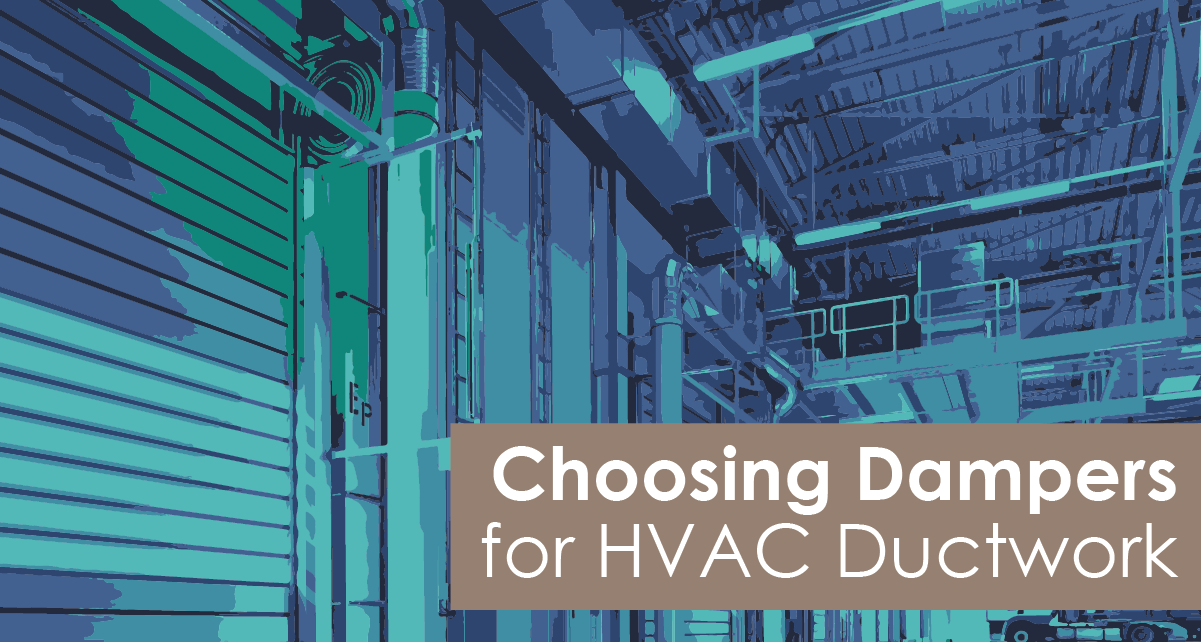HVAC systems are a complex network of ducts and equipment. How do dampers fit in? Learn how to choose dampers for your HVAC ductwork with the Newsstand.
Ductwork - The Roadways of Your HVAC System
From tiny homes to office buildings, every HVAC system will have a duct system in place. Ducts are the roadways for transporting air from the source to its destination. If ducts are the roadways, then dampers are the junctions that direct airflow.

Ducts and dampers go hand in hand in larger projects. As we discussed in a previous article, larger HVAC projects are commonly divided into zones using control dampers. Zones help focus the efforts of the system to the specific areas that need air conditioning.
Without zones, HVAC units would need to blast air through the entire system to cool one room. That would be a tremendous waste of power. Control dampers open and close to direct airflow to the correct zone.
Control dampers are important, but you will need more to maintain air performance through your ducts. Other damper types will support your system in various ways, like balancing air pressure at key points in your ductwork, or providing a relief point in areas with excess pressure.
There are many choices you will have to make when designing a duct system. In this article, we will discuss what you need to know to choose the right dampers for your ductwork.

For more on dampers, check out these Newsstand articles:
- Control versus Balancing Dampers - The Difference Between Dampers
- The Condenser - Temperature Limits for HVAC Dampers
- Air Performance and Control Dampers
Square or Round?
Ducts can have one of several shapes: square, rectangular, oval, and circular. To simplify this, we have narrowed the options down to square or round. The shape of the damper should match the shape of the duct, but they don’t have to be the same.
Transition collars provide the means to install dampers of any shape onto a duct. Learn more with our article on sleeves and transitions. You can also mix and match collars to join ducts of different shapes together.
Collars can only be on-face mounted, meaning the damper will always be outside of the duct when installed. This has advantages and disadvantages. The damper’s frame will be out of the airstream when mounted on the duct face, which lessens the loss in air pressure as air moves through the open damper.
However, the damper will need additional hardware for support. Also, transition collars require additional maintenance to freshen the caulk seal between the collar and the damper. If left to deteriorate, this seal can create air leakage which will impact the damper’s capabilities.

The best option is to match the damper’s shape with the shape of the duct. For spiral ducts, use a round damper for the best fit with the duct. This also lets you choose between in-duct or on-face mounting.
Match square and rectangular dampers with similarly shaped ductwork. This allows you to install the damper into the duct, creating a tight fit between the damper and the duct.
In-duct mounting ensures the damper stays secured inside the ductwork. You can still choose to install the damper on the duct face. This mounting method provides easier access to the damper during maintenance, as well.
What Damper Types?
You will use several types of dampers throughout your HVAC system. You will need control dampers to help create zones, but you may also need other damper types to help keep air moving. Which type you choose depends on what you need at that point in the ductwork.

- Balancing dampers maintain air pressure through the duct. If doors randomly close, or you notice hot and cold spots in a room, then you will need balance dampers to help alleviate the pressure imbalance. This ensures that air is distributed evenly across the system.
- Backdraft dampers are for one-way airflow. These dampers can be used for a variety of applications, including exhaust applications and pressure relief. If you have ductwork with consistently high pressure, consider adding backdraft dampers to help relieve it.
- Multi-zone dampers are designed for projects that have multiple zones and only one HVAC unit. Each damper panel will be connected to a duct that leads to a specific zone in the building. The zones of the damper will open as needed, providing airflow to areas that need it.
- Industrial dampers provide airflow control for major industrial projects, including factories and warehouses. Industrial dampers can be control dampers, balancing dampers, or backdraft dampers. These are heavy-duty dampers, built for the intense airflow required for industrial projects.
Your HVAC system will many damper types across its ductwork. Airflow conditions will change from duct to duct, depending on a wide range of variables. You can equip your system with the right tools by understanding what you need at which points in the system.
Static vs Dynamic Pressure
Airflow involves balancing static and dynamic pressure in your ductwork. Read "Balanced Flow" for a more complete overview of these pressures. To put it simply, adding more equipment will increase the static pressure inside the duct.
Your system will need to generate more dynamic pressure, by increasing fan speed, to overcome the extra static pressure. This will require more power from your system to move the same amount of air.
 More obstructions create more static pressure, which requires more dynamic pressure from system fans.
More obstructions create more static pressure, which requires more dynamic pressure from system fans.
In HVAC, we use the term “pressure drop” to describe the amount of pressure lost when air moves through an open damper. Check the submittals for your dampers for pressure drop data.
Dampers are required at certain points in the system, but it's important to understand their impact on your system before adding them to the duct. This can help you design an efficient system.
You should also understand the damper's limits.
Know the Limits
Every damper will have its limits. Static pressure and air velocity will be different from duct to duct. Not all dampers are designed to withstand the same conditions. Control dampers will typically have a maximum static pressure and a maximum air velocity.
Check the damper’s submittal for the specific values. These limitations will help you determine whether the damper will work for a particular duct.

If conditions in the duct exceed these limits, then the damper may not operate when it’s needed. Dampers can fail if they try to close against excessive air pressures or high velocities, which could damage the duct. Failures in ductwork can cascade to other sections of the system, causing more damage further down the line.
Choose dampers that can safely operate in the duct. Determine the operating pressure and velocity of the duct before choosing dampers. And remember, the damper will cause a drop in air pressure when installed. Always make sure your dampers are working within their limits.
Understanding the Needs of the Project
Understand the needs of your system first. Engineering teams can help with calculating air velocity and air pressure at various points in your ductwork. This will help you determine where dampers should go and what types of dampers you will need for your ducts.
From there, you can find the impact these dampers will have on your system. This can help you adjust your designs to find the most efficient setup for your system.

It’s important to have a plan before selecting dampers. With the big picture in place, you can choose the right dampers for your HVAC system.
Ready to add some dampers to your ductwork? Contact Arrow United Industries. We can help you build the perfect dampers for your HVAC system.
What traits do you look for in a damper? Tell us in the Comments section. We want to hear from you!
.webp?width=91&height=70&name=MCDLG%20Logo%20(Resize).webp)






